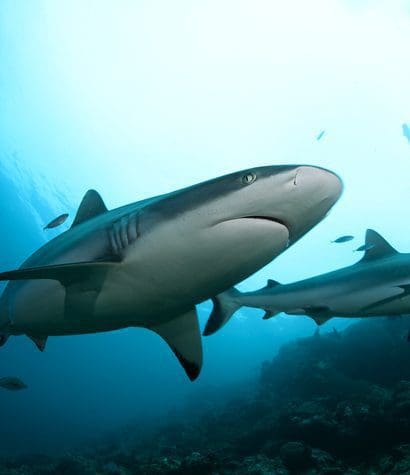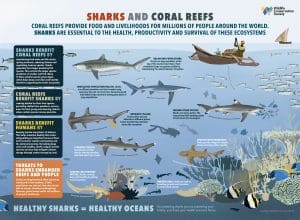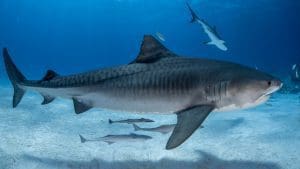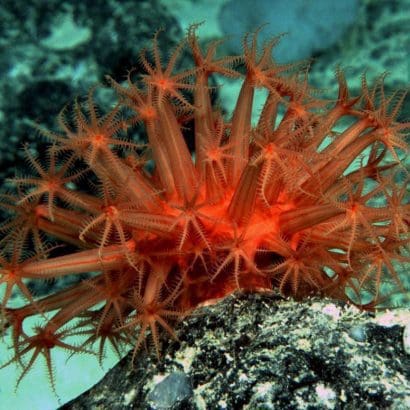
Sharks have long been captivating creatures of the ocean, shrouded in mystery and awe. As enigmatic predators, they have earned a formidable reputation as masters of the deep. Throughout history, these magnificent creatures have been both feared and revered, featuring prominently in various cultural mythologies and narratives. Their streamlined bodies, sharp teeth, and ancient lineage have made them a subject of fascination for scientists, conservationists, and enthusiasts alike.
In this article, we will delve into the world of sharks, exploring their unique characteristics, diverse species, and their vital role in marine ecosystems. From their exceptional adaptations for life in the water to their essential position as top predators, sharks play an irreplaceable role in maintaining the delicate balance of ocean life. Additionally, we will discuss the interactions between sharks and humans, dispelling some misconceptions and shedding light on the importance of conserving these mysterious creatures and their habitats.
Contents
General Characteristics of Sharks.🐟
Sharks, as magnificent marine creatures, possess a set of unique features that set them apart from other ocean dwellers. Their awe-inspiring physical attributes and remarkable adaptations enable them to thrive in the aquatic environment. In this section, we will delve into the general characteristics of sharks, including their physical description and their remarkable adaptations for survival and hunting in the ocean.
Physical Description:
Sharks boast a highly distinctive and streamlined morphology perfectly suited for life in the water. Their bodies are designed to reduce drag and maximize swimming efficiency. Typically, sharks have a torpedo-shaped form, featuring a fusiform body that tapers at both ends. This hydrodynamic structure allows them to glide effortlessly through the water, attaining impressive speeds as they navigate the ocean currents..
Adaptations to the Aquatic Environment:
Surviving in the vast and challenging marine realm requires specialized adaptations, and sharks have evolved an impressive set of features to excel in their underwater habitat.
- Buoyancy control: Sharks possess a unique liver that is rich in oils, known as squalene, which helps them maintain neutral buoyancy. This allows them to stay afloat without expending excessive energy, unlike many bony fish that need to keep swimming to avoid sinking.
- Fin design: Sharks’ fins play a crucial role in their locomotion and maneuverability. The pectoral fins, located on the sides of their bodies, aid in steering and controlling vertical movements. The caudal fin, or tail fin, is instrumental in propelling them through the water with speed and agility.
- Ampullae of Lorenzini: These specialized sensory organs found around a shark’s head are responsible for their electroreception capabilities. By detecting faint electrical fields generated by prey or objects, sharks can navigate and locate potential meals even in dark and turbid waters.
- Salt regulation: To survive in a saline environment, sharks possess a unique system that conserves water and excretes excess salt, allowing them to maintain osmotic balance and prevent dehydration.
Diversity and Habitats.🐟
Sharks exhibit an impressive diversity of species, each uniquely adapted to thrive in various marine environments around the world. In this section, we will explore the general information about the diversity of sharks, as well as highlight some common species and their distinctive characteristics. Additionally, we will delve into their global distribution, shedding light on the different regions where sharks can be found and their habitat preferences.
Common Shark Species and their Distinctive Characteristics:
-
- Great White Shark (Carcharodon carcharias): Perhaps one of the most iconic shark species, the Great White Shark is renowned for its large size, powerful build, and fearsome reputation as a formidable predator. With its signature white belly and dark gray dorsal surface, this species is well-suited for stealthy hunting from below.
- Hammerhead Shark (Sphyrnidae family): The Hammerhead Shark stands out for its unique head shape, resembling a hammer or T-shaped structure. This distinctive feature is thought to enhance their sensory capabilities, giving them a broader field of vision and enhanced electroreception.
- Tiger Shark (Galeocerdo cuvier): Known for its striking pattern of dark vertical stripes, the Tiger Shark is a versatile predator, earning it the nickname “garbage can of the sea” due to its varied diet. This species is renowned for its curiosity and ability to consume a wide range of prey, including fish, turtles, seabirds, and even debris.

- Whale Shark (Rhincodon typus): As the largest fish species on the planet, the Whale Shark is a gentle filter feeder, primarily consuming plankton and small fish. Despite its massive size, this species is known for its docile and non-threatening behavior towards humans.
Geographical Distribution and Habitat Preferences:
Sharks inhabit diverse aquatic habitats across the globe, from coastal areas to open ocean waters. Their distribution is influenced by factors such as water temperature, food availability, and breeding grounds.
-
- Coastal Areas: Many shark species are commonly found in coastal waters, where they hunt for fish, crustaceans, and other marine organisms. Examples include the Bull Shark (Carcharhinus leucas) and the Lemon Shark (Negaprion brevirostris).
- Open Ocean: Some pelagic species prefer the open ocean, often covering vast distances during migrations. The Blue Shark (Prionace glauca) and the Mako Shark (Isurus oxyrinchus) are well-known examples of open-ocean sharks.
- Coral Reefs: Certain shark species are closely associated with coral reefs, relying on these vibrant ecosystems for food and shelter. The Reef Shark (Carcharhinus amblyrhynchos) is a common inhabitant of coral reef environments.
- Deep Sea: The mysterious depths of the ocean also host unique shark species adapted to extreme pressure and low light conditions. The Goblin Shark (Mitsukurina owstoni) is an intriguing example of a deep-sea dwelling shark.
The Role of Sharks in the Marine Ecosystem.🐟
Sharks play a critical role in the complex web of life within the marine ecosystem. As apex predators, they occupy the top of the food chain, exerting profound influences on the populations of other species and shaping the dynamics of marine food webs. In this section, we will explore the general significance of sharks in the marine ecosystem and delve into two specific aspects of their ecological impact: population control and their position as top predators within the marine food web.
Population Control:
Sharks act as vital regulators of marine populations, ensuring a balance among different species within their habitats. By preying on various marine animals, sharks control the abundance of prey species, preventing their unchecked proliferation. This, in turn, prevents potential negative consequences, such as overgrazing of marine vegetation or the depletion of smaller species due to unrestricted reproduction.
Role in the Marine Food Web:
As apex predators, sharks occupy the highest trophic level in the marine food web. They have few natural predators themselves, which places them in a position of top-down control within the ecosystem. Their presence and activity directly influence the abundance and behavior of the species they prey upon.
Sharks’ predation influences:
The distribution and behavior of mid-level predators, which in turn influences the populations of their prey species. This cascade effect ripples through the entire food web, ultimately affecting the structure and stability of marine ecosystems. Without sharks, the population of mid-level predators could explode, leading to a decline in their prey species and potentially destabilizing the entire ecosystem.
Adaptations and Hunting Abilities.🐟
Sharks are remarkable predators, equipped with a set of extraordinary adaptations and hunting abilities that have honed their skills as efficient and successful hunters. In this section, we will explore the general information about the adaptations that contribute to their hunting prowess, and then delve into two specific aspects of their hunting abilities: their acute senses and their strategies for capturing prey.
Acute Senses:
-
- Olfaction: Sharks possess an exceptional sense of smell that surpasses that of most other marine creatures. Their olfactory organs, known as olfactory bulbs, are highly developed and can detect minute traces of blood and bodily fluids from considerable distances. This heightened sense of smell enables sharks to track wounded or distressed prey, even in vast ocean expanses.
- Electroreception: Another unique ability of sharks is electroreception, facilitated by specialized sensory organs called the ampullae of Lorenzini. These organs detect the weak electrical fields emitted by living organisms, including prey items. This remarkable adaptation allows sharks to sense the presence and movement of potential prey hidden in the surrounding water, granting them a tactical advantage in the hunt.
Hunting Strategies:
-
- Ambush: Some shark species, like the Great White Shark and the Tiger Shark, are known for employing ambush tactics. They lurk in the depths, remaining virtually invisible to their prey, before launching rapid attacks from below. This element of surprise catches their prey off guard, increasing the chances of a successful capture.

- Speed and Agility: Other shark species, such as the Mako Shark and the Blue Shark, rely on their exceptional speed and agility to hunt down their prey. They are capable of reaching astonishing speeds, allowing them to chase down and capture fast-moving targets like schools of fish. Their streamlined bodies and powerful muscles enable them to execute swift and precise maneuvers during the pursuit.
- Ambush: Some shark species, like the Great White Shark and the Tiger Shark, are known for employing ambush tactics. They lurk in the depths, remaining virtually invisible to their prey, before launching rapid attacks from below. This element of surprise catches their prey off guard, increasing the chances of a successful capture.
Relationship with Humans”
Sharks have a complex and often misunderstood relationship with humans. As enigmatic creatures, they have both fascinated and frightened people for generations. In this section, we will explore general information about the interactions between sharks and humans, and then delve into two specific aspects of this relationship: close encounters and the impact of fishing on shark populations and the ecosystem.
Close Encounters:
While shark attacks on humans do occur, they are incredibly uncommon. The vast majority of shark species are not interested in humans as prey and do not actively seek out human encounters. Most incidents involving sharks and humans are cases of mistaken identity, where the shark confuses a human for its usual prey, such as seals or fish. In such instances, the shark’s release of the human after the initial bite highlights their lack of interest in preying on humans.
Shark attacks, although tragic when they occur, are statistically very rare. Many species of sharks have never been known to attack humans, and the odds of encountering a dangerous shark in the ocean are incredibly low. Despite the rarity of shark attacks, media sensationalism and misrepresentation have contributed to a widespread fear of these creatures.
Impact of Fishing:
Sharks face a significant threat from human activities, primarily due to overfishing and bycatch. Commercial fishing practices often target sharks for their fins, which are highly valued in certain markets, leading to the cruel and wasteful practice of shark finning. The demand for shark fins for traditional Asian dishes, such as shark fin soup, has fueled this unsustainable and devastating trade.
Indiscriminate fishing techniques, like longline and trawl fishing, also result in significant bycatch of sharks. Many sharks are unintentionally caught in fishing gear targeting other species, leading to their injury or death. The decline in shark populations has serious consequences for marine ecosystems, as they play a crucial role in maintaining balance and biodiversity.
Conservation and Protection.🐟
Sharks, as enigmatic and awe-inspiring creatures, deserve our admiration and protection. They are not only an essential component of the marine ecosystem but also an indicator of its overall health. By conserving and protecting sharks, we contribute to the preservation of the world’s oceans and the myriad of life forms they sustain.
As guardians of the seas, it is our responsibility to ensure that these magnificent creatures continue to roam the oceans for generations to come. By promoting sustainable fishing practices, advocating for shark finning bans, establishing marine protected areas, and supporting scientific research, we can collectively work towards a brighter future for sharks and the entire marine ecosystem.




